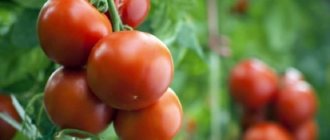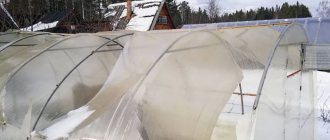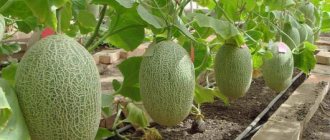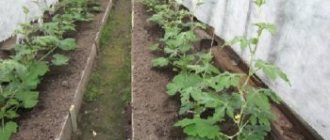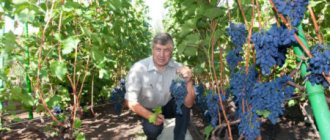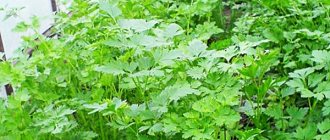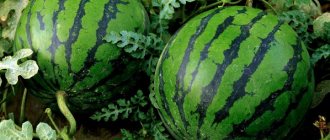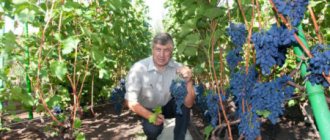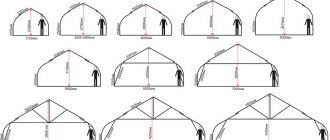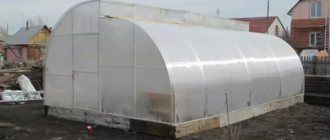Features of the design of a greenhouse for wintering bees
An ordinary polycarbonate greenhouse can be used in winter as a greenhouse.
Wintering bees in a polycarbonate greenhouse is the most competent, environmentally friendly solution for bees
The main functions that a bee wintering room should perform:
- protection from noise, temperature changes and strong winds;
- creating an optimal air humidity regime;
- feed savings;
- extending the service life of hives.
Bee on the snow
If we leave the greenhouse in its original form, it will not be able to fully fulfill all its tasks. So, on sunny days it will heat up more than on cloudy days. The situation can be corrected by laying a light-proof material on top of the polycarbonate sheets - roofing felt or glassine. And in order to protect the room even more reliably from temperature changes, it’s a good idea to add additional thermal insulation on the inside. Insulation made from foamed polystyrene or sheet foam are suitable for this purpose.
Alternative option (external insulation of the greenhouse with polystyrene foam)
Additional insulation of hives
Thermal insulation will protect not only from frost. With the arrival of spring, when it becomes warm outside, the shelter will be cooler, so the bees will not fly out of the hive prematurely. Regulate the temperature in the room using ventilation vents and doors. So, at the very beginning of wintering, when the weather is constantly changing, the beekeeper will have to be very careful and control the temperature regime. Overheating is especially harmful for bees, so keep the windows and doors open on warm days, and close them on cold days.
Modern technologies for wintering bees
Important! The difference in temperature between the room and the hive contributes to increased humidity. Monitor the air humidity in the greenhouse using measuring instruments. The normal value is in the range of 75-80%. Adjustment of indicators is achieved by increasing or decreasing the flow of fresh air.
The influence of temperature in the winter hut on the results of wintering of bee colonies
When placing hives in winter, be sure to take care of protection from rodents. Make special metal stands for the hives, and protect the entrance with a metal mesh. If there are a lot of hives and you have to arrange them in two tiers, then make racks from metal profiles or fittings. Place the hives with the strongest families at the bottom, and place the weak ones at the top.
Polycarbonate prices
polycarbonate
Advice from experienced beekeepers
For a successful wintering of bees, experienced beekeepers advise adhering to the following basic rules and recommendations:
- maintaining complete peace and darkness in the winter hut, since sound and light can lure bees out of the hives;
- prevent the entry of rodents that can damage the hive or disturb insects;
- regularly listen to the noise in the hive, which will help diagnose the condition of the whole family: the absence of noise signals the bees are starving, and high noise indicates crystallization of food.
Every beekeeper thinks about how to organize the wintering of their insects. So, in order to successfully overcome the cold season, it is necessary to follow the rules for heating the greenhouse, the temperature regime and not to forget about equipping the room with ventilation.
Preparing bees for winter
The biological health of bees is of paramount importance for successful wintering. Bees that work on honey collection before the onset of cold weather rarely survive until the next season. The situation is similar with bees raising brood in September or October. An experienced beekeeper begins to prepare bee colonies for wintering in mid-summer.
Honey after summer pumping must be left in sufficient quantity to feed the bees during wintering. On average, 1 kg of live weight of bees consumes 8 kg of honey over the winter. In practice, this amount depends on wintering conditions and the breed of bees.
Table. Average data on feed consumption.
| Wintering method | Feed consumption (kg) per 1 kg of live weight of bees |
| In casings | 7-8 |
| Under the snow | 8-8,5 |
| In Omshanik | 7-7,8 |
Before sending bee colonies for the winter, collect nests. For a family with 2.5 kg of live weight, when assembling, you will need to leave 15 to 20 kg of high-quality honey in the nest and a stock of about 10 kg in the warehouse. It is more convenient to send strong families for the winter in two-hull hives, with most of the food supply located in the upper building.
Methods for assembling bee nests for the winter: A - double-sided (vault), 1 - frames with honey, 2 - a club of bees on empty honeycombs; B - one-sided (angle); B - beard
Assembling a bee nest for the winter
Assembling a multi-body hive nest
It is important to place the frames correctly in the hive. Those of them where it is planned to form a club must have a supply of honey of at least 2 kg. Full copper frames should be placed around the edges of the hive. With the correct configuration of the nest, full-copper and low-copper frames alternate with each other - this prevents the death of bees with sufficient food supplies due to the fact that they were unable to reach the frames with honey.
Placing feed in combs for the winter
Important! The feed stock should not include frames with honeydew honey or honey from the last harvest from crops such as sunflower or cruciferous plants. Before wintering, they must be replaced with frames with summer honey, previously left for these purposes.
Top view of the nest before wintering
To stop late brood, feed the bees with sugar syrup. Optimally for making syrup, add sugar at the rate of 3 kg per 2 liters of water. Increasing the concentration may cause the syrup to crystallize and make it difficult for bees to use. A weaker solution may turn sour - to avoid this situation, we recommend adding a little acetic or citric acid to the finished syrup. The cooking rule is to first boil water and then add sugar. Otherwise, it simply will not dissolve completely. It is not recommended to boil the syrup for a long time; it is better to simply remove it from the heat after adding sugar and stir thoroughly until completely dissolved. Feeding should be plentiful.
Assembling nests in winter
It is useful to combine sugar feeding with disease prevention - just add the desired drug to the syrup. Fumagilin-B helps well against the common disease nosematosis.
"Fumagilin-B" in the treatment of nosematosis of bees
Drug for treating bees "Nozemat"
It is important that before the onset of winter dormancy, the bees have time to fly around efficiently and empty the intestines of feces. If you place bees in a wintering room before they make a full flight, in the spring you can find a weakened and thinned colony in the hives, completely unprepared for the nectar collection season.
Prices for Nozemat
Nozemate
Preparing the uterus is a very important stage
The successful wintering of a bee colony directly depends on the health, age and quality of the queen. Young one-year-old queens produce the highest brood. A good technique for sending a family with a strong queen to winter is the use of temporary layering. Bees from temporary layers are combined with the main colonies, old queens are replaced with fresh ones.
Queen bee
For ease of work, each uterus should be marked with coloring. One-year-olds - one color, two-year-olds - another, etc. In this way, it is easy to cull the old queen and replace it with a younger one. In large apiaries, it is advisable to assign a number to each queen and attach it to the hive in which she is placed. When the queen is moved to another hive, the number is moved with her. It is recommended to keep a separate notebook for each hive with records of work performed, indicating dates and times. This makes caring for bee colonies very easy.
It is advisable to mark each uterus
Dadan
Hives designed by Dadan-Blatt are very popular among beekeepers today, which can be explained by their simplicity of design, ease of maintenance and maximum convenience for bees. Making such a bee house will not be difficult for any beekeeper. It is recommended only for this work to use wood that contains a minimum of resin . This Dadan is made on 12 frames with standard external dimensions of 435 by 300 millimeters. For the extension, you can use magazine frames 435 by 145 millimeters.
On the Internet you can easily find various drawings of Dadan hives, which will allow you to easily complete them yourself. It is only necessary to observe the dimensions of the structure and qualitatively process the wood that will be used to make such a hive. Among the features of Dadanovsky hives, we note their high design, which will require the beekeeper to frequently install additional magazine frames to prevent swarming.
Preparing the hives
In an unheated greenhouse, it is recommended to insulate the hives from the outside. It is convenient to use foam sheets for these purposes. The upper and lower tapholes should be left open, slightly reducing the width of the gap. Inside the hive, complementary food is placed on a stocked nest and covered with canvas. Near the back wall, the canvas is turned back a little to create conditions for better ventilation of the hive.
The nest is covered with canvas
An insulating cushion of moss or other loose and hygroscopic material is placed on the canvas, and then the top cover is installed.
Beehives in a greenhouse
Ice in the hallway in front of the entrance is one of the possible consequences of improper preparation
After the hives are prepared and placed for wintering in compliance with all standards, the beekeeper is not recommended to disturb the peace of the bees with his presence. Limit yourself to controlling temperature and humidity and occasionally (no more than twice a month) conduct a visual inspection of the hives. If the bees feel uncomfortable in any of them, which you can tell by the uncharacteristic buzzing of the hive, carefully open it and check for the reason.
Hive inspection
When inspecting in darkened greenhouses, turn on the lighting in red.
Construction of a bee house
The classic structure of a bee hive usually consists of the following elements:
- Bottom, side, back and front walls.
- The roof liner, above which there is an insulating cushion.
- Roof frame, gable roof.
- Tray and landing board.
- Ventilation hole.
- Small waste tray.
- Glass that allows you to observe the behavior of bees.
- Frames located inside the hive.
- Additional magazine extensions.
All these elements are fastened into a single insulated structure. It should be said that increased demands are placed on the size and structure of the hive, so it is necessary to strictly adhere to all recommended dimensions when manufacturing them.
How to determine the best time to exhibit bees for the winter
Autumn weather is changeable. After short-term cold weather, warming may occur. Prepared hives are placed in a permanent wintering place only with the onset of stable negative temperatures. This way you give the bees the opportunity to make a quality pre-winter flight. The hives must be well dried before the exhibition, so they cannot be moved to the wintering site in inclement weather - only a dry day is suitable for this. A suitable time of day is late evening or even night. At this time, all the bees have already returned to the hive and their activity is minimal.
You can throw snow into the greenhouse so that the temperature does not rise sharply later
Growing eggplants in a polycarbonate greenhouse
In warm climates it is grown in open ground, but in those regions not spoiled by heat, eggplants are planted only in greenhouses. You will find more detailed information about this in this article.
Advantages and disadvantages of polycarbonate greenhouses for wintering bees
Using greenhouses for wintering has many advantages. Let's list just a few.
- Low cost and ease of installation. The finished greenhouse can be easily installed in one day.
- For regions with a mild climate, the use of greenhouses allows you to save weak families from death.
- If the bees did not have time to fly around before wintering, then it is easy to create conditions for flying around in the greenhouse by simple heating. This can also be done at the end of winter, when the bees already need to cleanse their intestines, but the weather is not yet very suitable for exhibiting outside.
- Winter care of hives is carried out in comfortable conditions.
- At subzero outside temperatures, bees are not disturbed by daylight. If your greenhouse maintains indoor temperatures between 0 and 4 degrees Celsius, apply shade to prevent bees from being disturbed. Also make sure there is no noise.
- For areas with rainy autumn months, you can prepare nests directly in the greenhouse. If the temperature outside is still high, then the prepared hives should be taken outside before the onset of stable cold weather.
Wintering of bees
Important! The only disadvantage that should be highlighted is that the wintering of bees in a greenhouse must be under constant supervision. This option is only acceptable if the greenhouse is located near the beekeeper’s place of residence. This method is not suitable as a country option.
When flying around in greenhouses, bees often lose orientation, a certain percentage of them die - they fly without noticing barriers made of transparent material, and lose strength trying to break through them. The situation can be corrected by placing frames of honey in the corner for drying. A busy bee will not become disoriented.
In such a transparent greenhouse, bees feel like they are in a “black box” and are unable to navigate
Bee products are not only sweet and aromatic honey. Propolis is used in medicine, folk healers use death, cosmetologists add wax to the composition of miraculous ointments, it is widely used in the manufacture of candles and other areas. Bee stings have a healing effect for many ailments.
Honey has many beneficial properties
The work of a beekeeper is very difficult and full of risks. A lazy person shouldn't even try to keep bees. In addition to a large amount of knowledge, which must be constantly replenished with your personal observations and experiments, an apiary requires a large investment of physical labor and financial investments. The most persistent and persistent beekeepers achieve success.
Air temperature in winter
If you use simple polycarbonate without improving it or supplementing it with other materials, then the air temperature will fluctuate slightly. This is especially noticeable during severe frosts in winter or in spring, when the sun heats the greenhouse. You can monitor how the bees feel in the greenhouse by sound:
- If a strong hum is observed in weak families, this means that the air temperature has dropped too much for them and it is advisable to warm up the room. Additionally, you should limit the flow of cold air into the room.
- If strong bee colonies create a restless hum, then you should urgently ventilate the room, as this means increased temperatures.
Try to maintain temperatures around -5+5 degrees. It is more convenient to do and control if you use additional materials for insulation. Thus, the temperature inside the greenhouse will be approximately the same throughout winter and spring, until it is time to release the bees for their first flight.
